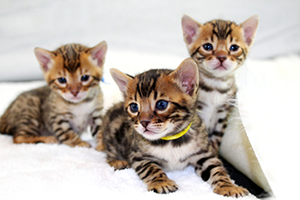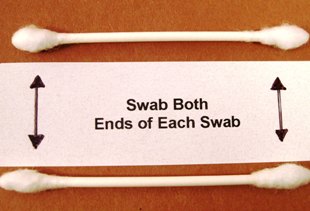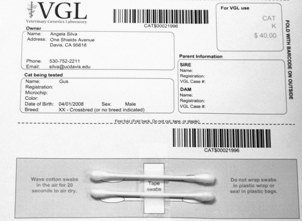Quick Summary
Click here for Price and Turnaround Time
Phenotype: Cats affected by hypertrophic cardiomyopathy (HCM) are at risk of sudden cardiac death. In Maine Coon cats with two copies of the disease-associated mutation, moderate to severe cardiac disease can lead to sudden death by age 4 years or less. Cats that carry one copy of the mutation have a longer life expectancy, but may still develop HCM.
Mode of Inheritance: Autosomal dominant (incomplete penetrance)
Alleles: N = Normal, HCMmc = hypertrophic cardiomyopathy-associated mutation
Breeds appropriate for testing: Maine Coon
Explanation of Results:
- Cats with N/N genotype are not predicted to be at increased risk of HCM and cannot transmit this hypertrophic cardiomyopathy-associated mutation to their offspring.
- Cats with N/HCMmc genotype are 1.8 times more likely to develop HCM than cats without the mutation (N/N genotype). They will transmit this hypertrophic cardiomyopathy-associated mutation to 50% of their offspring.
- Cats with HCMmc/HCMmc genotype are 18 times more likely to develop HCM than cats without the mutation (N/N genotype). Cats with this genotype are at highest risk for sudden cardiac death.
Cat DNA tests are carried out using cells brushed from your cat's cheeks and gums using household cotton swabs.
The cat DNA submission form with instructions and a place to tape the cotton swabs is sent to you via email after you place an order, and can be printed from your home computer. DNA test kits are no longer mailed.
Instructions
Step-By-Step:
1.
 Purchase regular household cotton swabs for cat DNA collection (the cotton swabs can be purchased at a pharmacy or drug store)
Purchase regular household cotton swabs for cat DNA collection (the cotton swabs can be purchased at a pharmacy or drug store)
2.

Make sure the cat has not had anything to eat or drink for at least 1 hour prior to collecting sample.
When swabbing kittens, isolate each kitten from the mother, littermates and any shared toys for 1 hour prior to swabbing. Kittens should not have nursed or eaten for 1 hour prior to collecting sample.
If collecting samples from more than one cat, make sure to sample one cat at a time and wash your hands before swabbing another cat.
3.
 Use both ends of the two cotton swabs for a total of four swabs.
Use both ends of the two cotton swabs for a total of four swabs.
4.
Place the cotton head of the swab between the cat’s gums and cheek and rub or rotate the swab back and forth for 15 seconds. Repeat with each cotton swab head, for a total of 4 swabs. We recommend swabbing a different area of the gums with each swab head.
5.
Wave the swab in the air for 10-15 seconds to air dry it before attaching it to the submission form.
6.
 After swabbing the cheek and gums, tape the cotton swabs to the bar-coded submission form printed from your MyVGL account.
After swabbing the cheek and gums, tape the cotton swabs to the bar-coded submission form printed from your MyVGL account.
ATTENTION:
- Do not collect saliva/drool – the key to obtaining a good sample is getting cheek cells on the swab.
- Do not rub swab on the cat’s tongue or teeth – this will result in poor quality sample.
- Do not collect a sample from a kitten that has recently nursed – the mother’s genetic material can rub off on the kitten’s mouth and contaminate the sample.
Hypertrophic cardiomyopathy is the most common cardiac disease in cats. Affected cats are at risk of sudden cardiac death due to defects that produce increased left ventricular heart muscle thickness. In the Maine Coon breed, the A31P mutation in the cardiac myosin binding protein C gene (MYBPC3) has been found to be associated with increased risk for HCM. (See below for a summary of published research on HCM and Maine Coon cats.)
The A31P breed specific mutation for inherited HCM in Maine Coon cats produces moderate to severe cardiac disease which can lead to sudden death by age 4 years or less for cats that carry two copies of the mutation (homozygotes). Cats that carry one copy of the mutation (heterozygotes) have a longer life expectancy, but may still develop HCM. The mutation is a single base pair change in MYBPC3 that disrupts the production of the cardiac myosin binding protein C needed for normal heart muscle development.
Summary of published research regarding A31P mutation and Maine Coon HCM
(by N.C. Pedersen, DVM, PhD)
A number of papers dealing with the significance of the MYBPC3-A31P mutation in Maine Coons have recently been published. The data from these publications (referenced below), when analyzed collectively, have allowed a better understanding of the importance of this mutation in causing hypertrophic cardiomyopathy (HCM). This particular mutation has been found almost exclusively in the Maine Coon breed. About 63% of Maine Coon cats that were genetically tested but not clinically phenotyped (no echocardiographic imaging) for HCM were free from the mutation. This figure was 70% for cats that were both genetically tested and clinically phenotyped for HCM. The overall percentage of cats carrying one copy of the mutation (heterozygotes) was 34% in the non-phenotyped population and 26% among the phenotyped cats. The incidence of cats carrying two copies of the mutation (homozygotes) was 3% in non-phenotyped cats and 4% in phenotyped cats. Therefore, it is relatively certain that about two thirds of Maine Coons around the world are free of the mutation, and one third of them have one or two copies of the mutation. Two copies of the A31P mutation appear to cause considerable embryonic death based on the observed deficit of homozygotes, i.e., 7-16% homozygotes were expected but only 3-4% observed.
The mutation does not appear to behave as a simple dominant trait, but rather as a dominant trait with incomplete penetrance. The relative risk (RR) for HCM in cats carrying one copy of the A31P mutation is around 1.8 compared to cats that do not have the mutation. However, the relative risk for HCM in cats carrying two copies of A31P is around 18. Therefore, cats with one copy of the mutant allele are 1.8 times more likely to develop HCM than cats carrying normal alleles. Cats with two copies of the mutant allele are 18 times more likely to develop HCM than cats carrying normal alleles and 10 times more likely to develop HCM than cats with one copy of the mutant allele.
These studies have also identified HCM in cats that do not carry the MYBPC3-A31P. The incidence of HCM in these studies was 5.4% in cats that were negative for the A31P mutation, and 5.4% with the mutation. Therefore, the MYBPC3-A31P mutation is not the sole cause of HCM in Maine Coons. The other causes are not known at this time.
Additional information from these publications suggests that male cats may be twice as likely to be affected as females, and that heavier cats are more prone to develop HCM than lighter cats. However, this latter relationship may itself be attributable to a larger size for males than females. One study also suggested that more heterozygous cats may develop disease as they get older (>4 years), but this has yet to be convincingly proven, and most cases of clinical HCM still occur before 4 years of age. Nevertheless, the possible influence of such as factors as gender, weight and age indicates that non-genetic factors also contribute to overall disease risk.
Differences in results between these various studies can be attributed to a number of factors, probably the most important being sample size. Another factor concerns phenotyping. The criteria for judging whether a cat has HCM or not are not precise, leading one of the studies to classify cats as either normal, equivocal, or affected. The incidence and risk estimates given above were based on cats that were clearly normal or affected; cats that were graded as equivocal were not included.
Given the increased knowledge that has come forth from many sources, the VGL offers the MYBPC3-A31P mutation test for hypertrophic cardiomyopathy in Maine Coon cats. Hopefully, breeders will be able to use this information to improve the vigor of the breed. A better understanding of test results will also contribute to a more realistic appraisal of the value of the test in breed improvement.
